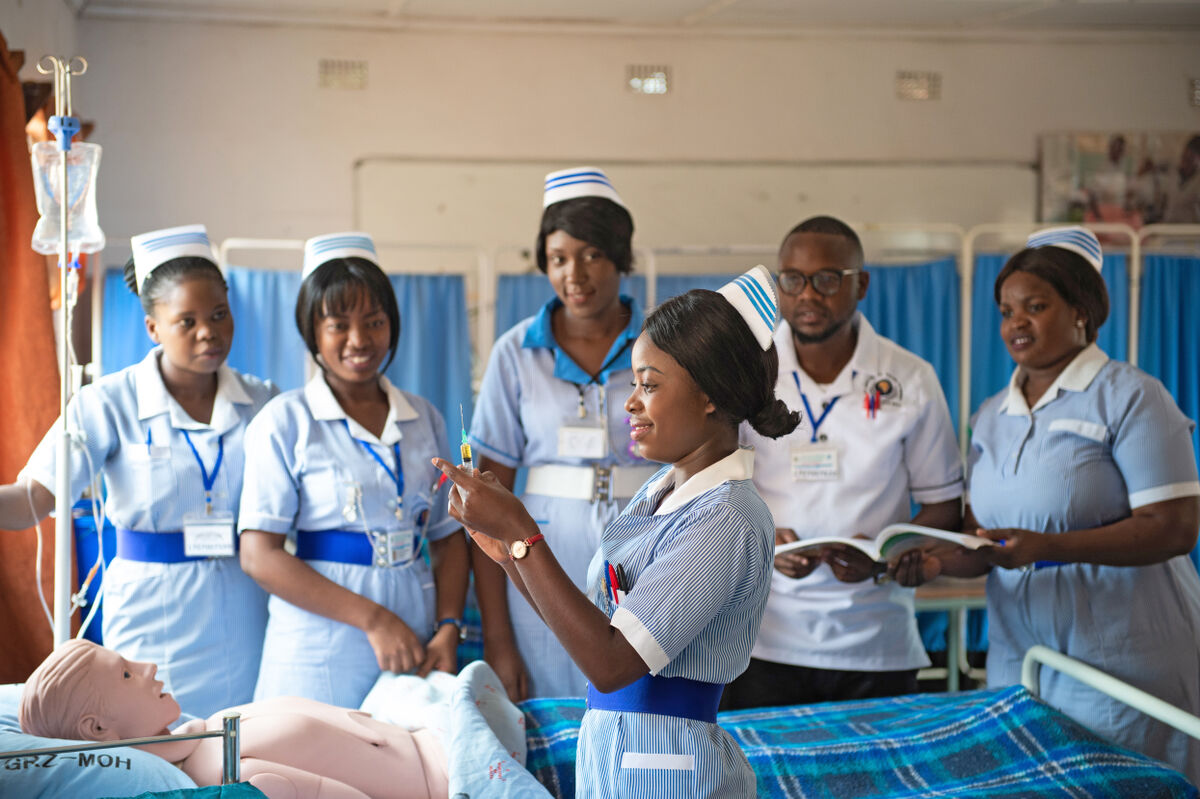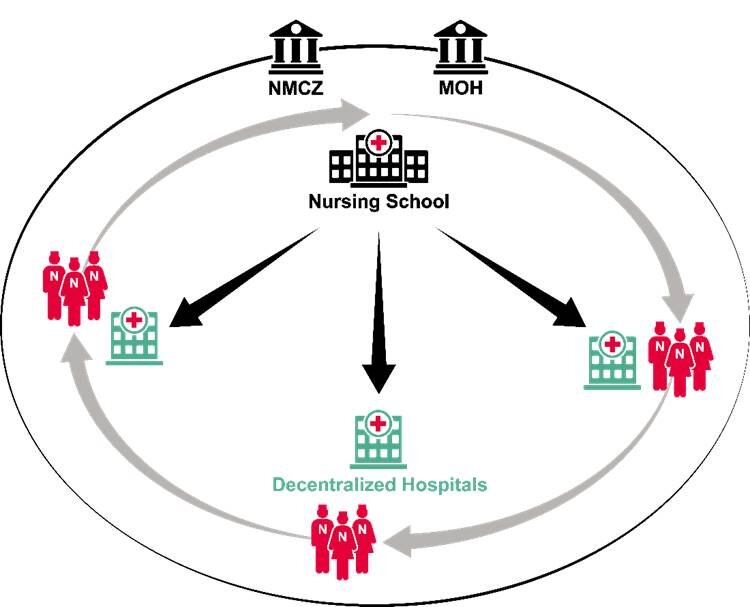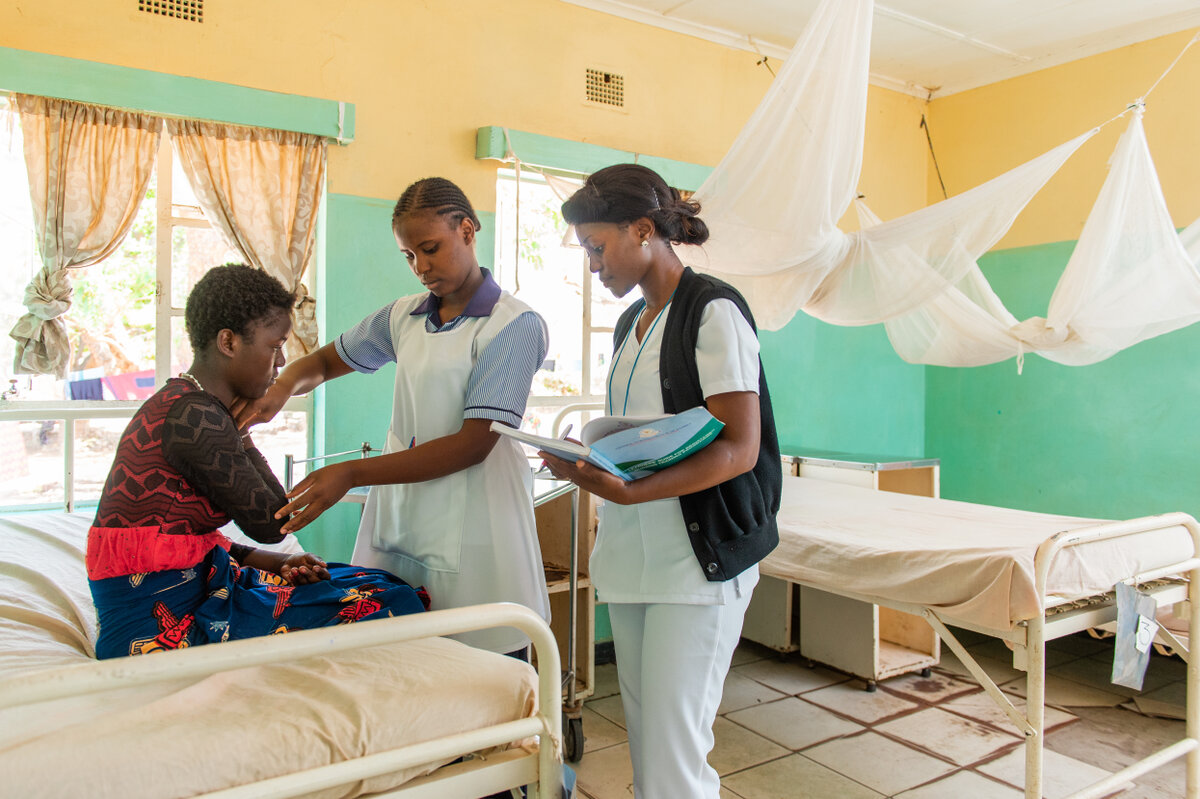- Exchange and Networking
- Knowledge and Learning
- Advocacy
- Our topics
By Amélie Gottier and Beatrice Zulu
Zambia’s severe health workforce shortage urged a change of the traditional model where each nursing school is attached to one teaching hospital for practical experience. Starting in 2012, SolidarMed successfully introduced an innovative model, which allows to train more nurses while maintaining good quality of the training. Key components of the model are decentralisation and increase of number of training sites, clinical mentoring of nurse students, rotation between the sites, combined teaching and blended learning. The model has been accredited by the Ministry of Health and is currently being rolled out.

Zambia continues to have one of the world's fastest growing populations. The UN projects that by 2050 its population will grow from 18 million to 39 million (Worldometer, 2020). This rapid growth significantly increases demands on the healthcare sector. Unfortunately, this situation is aggravated by a “human resources for health crisis” (Ministry of Health, 2017). Despite substantial investments and commitment, Zambia is still lacking about 40% of the estimated required health care workers (HCWs) (Ministry of Health, 2017). In 2019, only 13 nurses and midwives cared for 10’000 people, compared to 175 in Switzerland (World Health Organisation, 2020). The challenge of insufficient numbers is compounded by inequalities in the geographical distribution.In 2017, approximately 90% of trained HCWs were located in urban areas while 55% of the population live in rural areas (Ministry of Health, 2018).
The severe health workforce shortage and the unequal distribution of the health staff is one of the key challenges for Zambia to attaining Universal Health Coverage and SDG 3 for its population. To meet the healthcare needs of the growing population, the country needs to increase the number of HCWs by 26’000 to 73’000 (Ministry of Health, 2018). Over the past decade, the Ministry has stepped up its efforts to address the gap between Zambia’s current and the required output of newly graduated HCWs. Training of health professionals has been accelerated and intensified. However, many training institutions are now at full capacity and further increase in number of courses and size of classes risks jeopardizing the quality of education.
The challenge of insufficient numbers is compounded by inequalities in the geographical distribution.In 2017, approximately 90% of trained HCWs were located in urban areas while 55% of the population live in rural areas.
Professional health training therefore required new innovative models to meet these challenges. In 2012 SolidarMed developed and successfully piloted such a new approach with the decentralised nurse training model. The main goal is to increase the number of nurse students while maintaining a high quality of training. Furthermore, the focus was on rural settings to increase the likelihood of retaining the trained HCWs in rural health facilities. In this way, SolidarMed sought to address the imbalance of the rural versus urban distribution of HCWs.
The old model is based on the collaboration of one nursing school with one hospital. All nurse students at that school undergo their practical training in the attached hospital. The focus of the decentralised nursing model is to deliver high quality theoretical and decentralised practical training. Increasing the number of practical training sites that are linked to the school thus allowed to have more students at the same time. A central school provides theoretical training while several nearby rural partner hospitals offer the students practical training. Key elements of the model are:
The diagram below illustrates the concept of the innovative decentralised nurse training model in Zambia under the umbrella of the Nurse and Midwifery Council of Zambia (NMCZ) and the Ministry of Health (MoH).

The pilot was carried out in partnership with the Ministry of Health and St. Luke’s School of Nursing and Midwifery where the project started and where it was implemented. The Nursing and Midwifery Council of Zambia was involved in the project from the outset, to support both the pilot and the roll-out. SolidarMed acts as the facilitator, providing technical expertise to support the implementation process and resources for the implementation, thanks to the support of two major donors. This includes investment in infrastructure and equipment at the decentralised training sites.
The decentralised nurse training model has proven to be effective in doubling the number of graduated nurses. By the end of 2018, 469 nurses finished their training in the new model.In addition, a 2018 review showed that 61 percent of St. Luke’s graduates were posted to a rural health facility (General Nursing Council of Zambia, 2019).
The success of the pilot has been recognised by the Ministry of Health and the NMCZ. St. Luke’s School of Nursing and Midwifery, as well as the decentralised partner hospitals were accredited by the NMCZ thereby acknowledging that the quality standards for the students’ training are met. This recognition has boosted interest in the model from other training institutions. In 2019, SolidarMed initiated support for two additional nurse training institutions to implement the decentralised model. These two nursing schools have begun implementation while some others are planning to implement the model even without SolidarMed support but using the developed guidelines. One of the key guiding documents that was published by the Nursing and Midwifery Council of Zambia with support of SolidarMed and the Ministry of Health in 2019 is the Decentralised Nurse Training Model Implementation Guide. It lays out the necessary steps for the implantation and successful running of the model and thus provides guidance to institutions who wish to adopt the decentralised model.

The COVID-19 pandemic has demonstrated clearly the crucial role that qualified nurses play in the delivery of health care. It has also shown that learning and teaching via eLearning, webinars and digital working groups are valuable methods that can contribute to acquiring skills. Although such tools are not able to replace the crucial practical experience and exposure to patients in a clinical setting, under supervision and guided by a Clinical Instructor, they are beginning to add a valuable dimension to the student’s learning experience.
While SolidarMed is committed to providing technical expertise and to optimising the implementation of the decentralised nursing model, the current phase of the project comes to an end in 2022. SolidarMed is aiming at wider adoption of the decentralised training model without directly supporting the schools in the same way. To this end, two research studies are underway to assess two important questions. The first study is a cost comparison between the decentralised and the traditional nurse training model to confirm the assumption that the decentralised model is less costly than the traditional model. The main question is what the main drivers of costs in the two systems of nurse training are. The second study will analyse the impact of the decentralised training on quality of care provided by the nurses.
The results of these studies are expected at the beginning of 2021. Findings will be critical in future discussions with the Ministry of Health and the Nursing and Midwifery Council on the nation-wide adoption of the model. The decentralised nurse training model can contribute to decreasing the human resources for health gap in Zambia, a critical factor in improving the health of the population, especially those living in rural areas.